Peter Krashes "Block Party" is on view through October 28 at The CUNY Graduate Center’s James Gallery in Manhattan at Fifth Avenue and 34th Street. For information visit the James Gallery website.
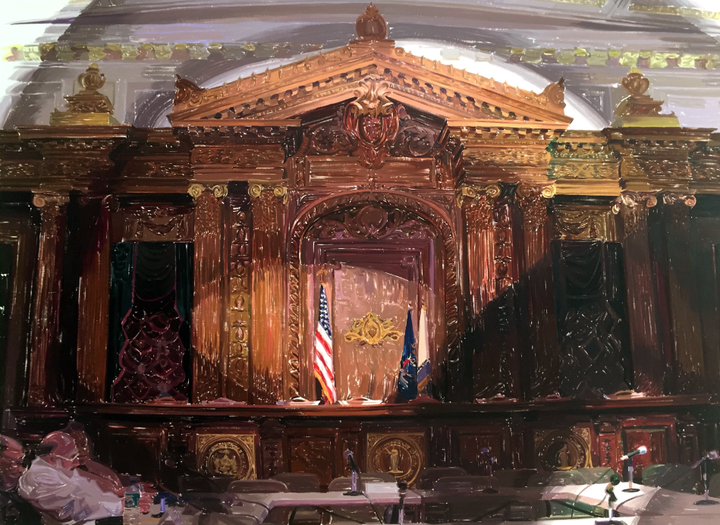
Peter Krashes, Empty Mics, 2006, oil on linen, 63x84 inches
Peter Krashes is a Brooklyn painter whose "Block Party" gouaches-on-paper at The CUNY Graduate Center’s James Gallery in Manhattan have been garnering surprising attention in the art press. Although the works are noteworthy for their essay of the triumphs and pitfalls of figurative painting as a means of memorializing and waging political activism, in a larger scheme, Krashes is more substantially asserting the revival of regional populism in art at a time when globalism and the market trends of an ever-increasing oligarchical art world dominate the selection of art seen at the art fairs, festivals, and high-end galleries. Although there is nothing particularly vanguard about the work (if that matters), Krashes quite defiantly, if gently, asserts his own alternative to what we might call the status-garde which has in recent decades surreptitiously come to define the audience whose tastes have replaced the avant-garde of the last two centuries.
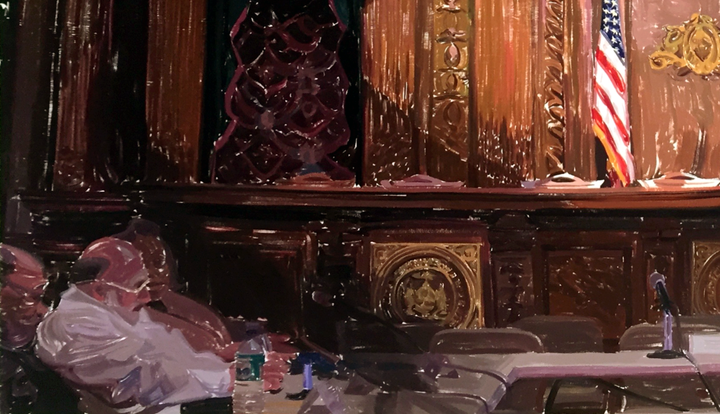
Peter Krashes, Empty Mics, 2006, oil on linen, 63x84 inches
While Krashes asserts a new, and apparently welcome, populism in art, he no less participates in furthering one of the most salient tropes of late modernist art: the re-rendering of photographed subjects. A few decades ago such a predilection for second-generation imagery would preclude populism. But in most cases those "postmodernists", as they were then called, appropriated the photography from the mainstream media rather than shoot it themselves. And, really, what can be more populist than carrying a camera so to repaint the subjects it photographs? This is, after all, the true reason that Krashes is garnering attention. Or, rather, this in conjunction with the local politics being memorialized by his painted renderings. He isn't just the reincarnation of Thomas Hart Benton challenging abstractionists from Kandinsky to Rothko. He is Thomas Hart Benton taking on Warhol to Prince. At least in this show, in which the subjects of Krashes' paintings are as much the glints, glares and auras that betray the omnipresence of lenses and photo flood lights as do the politicians, court clerks, reporters, dissenting locals, and other mediated subjects.
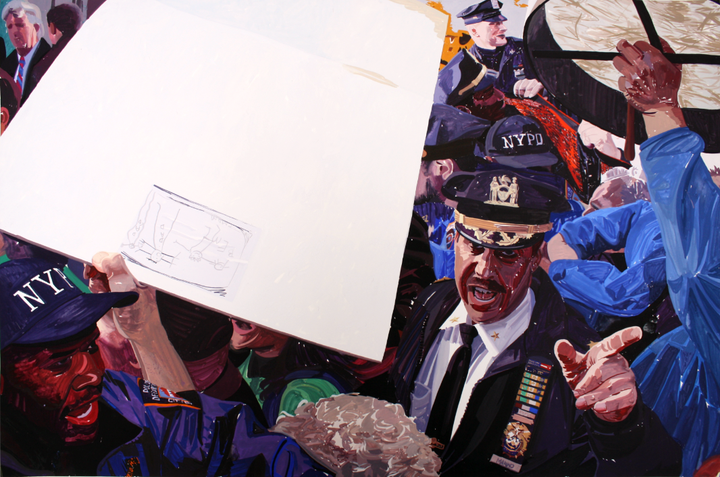
Making Noise to Be Heard, 2017, gouache on paper, 6.5 x 40 inches
In terms of painterly style (remember that antiquated phrase?), viewers of his work are fortunate to encounter more triumphs than shortcomings literally "highlighting" Krashes’ acumen as a painter and a stylist. But the James Gallery show, and really Krashes' premise for it, is encumbered for its championing regional rather than national and international subjects, as well as its favoring of banal events over sensationalized or celebrated traumas and catastrophes. Various writers, and Krashes himself, prizes the imagery for its admirable centering around his autobiographical participation as a community organizer some ten years earlier in the protests and events challenging the controversial Brooklyn Atlantic Yards/Pacific Park development. But the question remains whether the subject and its imagery is universal enough to travel globally as a populist challenge to corporate, governmental and legislative authority, entitlement and the disenfranchisement that results from them.
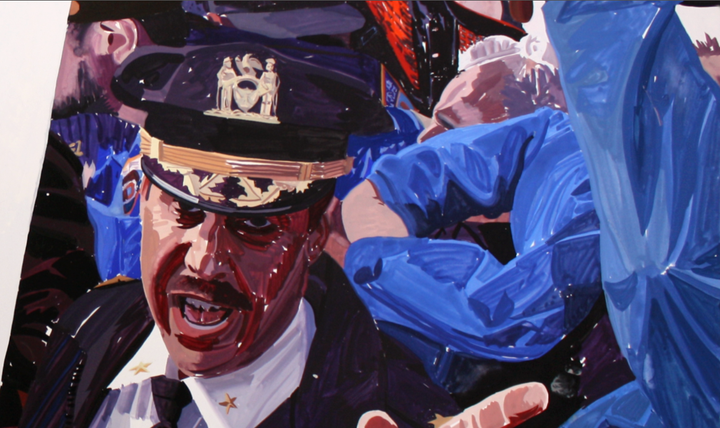
Making Noise to Be Heard, 2017, gouache on paper, 6.5 x 40 inches
This is problematic because Krashes’ skill as a pictorialist is the kind that transcends cultural barriers, which is why I've analogized him with Hart Benton, who succeeded in making the local and everyday subject iconic. Krashes' eye and hand guarantee that his isolation of a quiet moment in a local court chamber illuminated by a camera flood light can be appreciated in an exhibition in Moscow, Beijing or Istanbul. But will Krashes prizing of local democratic values be similarly apprized or even welcome there? Of course this is Krashes' intended challenge, and it's one that makes him (so far) gently problematic to authoritarian regimes. It helps that his imagery is realistically rendered, especially given that left-authoritarian powers have generally favored social realist art for its facilitation of immediately conveying the official party line and the hagiographic iconography of the supreme leadership. (See You Say You Want A Revolution) But perhaps I've gotten too ahead of the realities at hand.
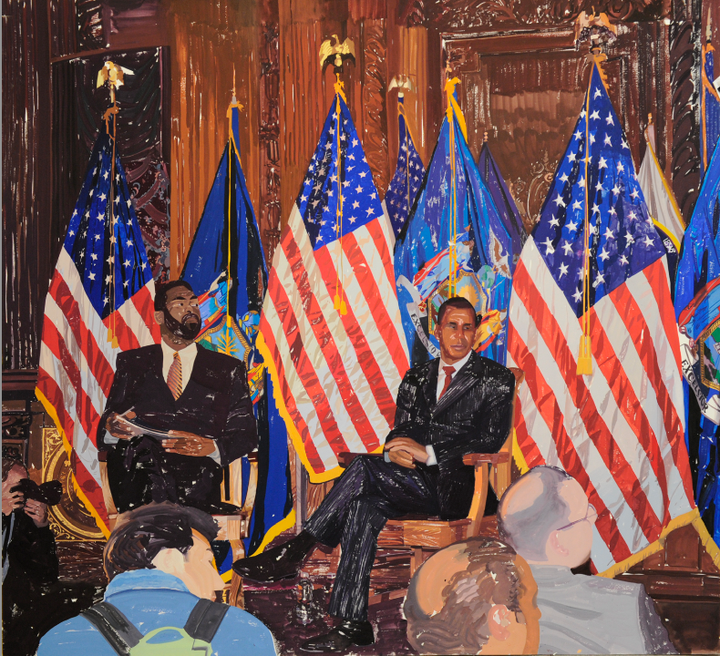
Peter Krashes, Governor and Flags, gouache on paper, 56.5 x 63 inches
The encumberment at hand is the question, How does an artist ensure her or his painted imagery is adequately universal yet relevant and vital after photography and abstraction have eroded painting's aura? In this, Krashes is in fine company, given that the art cognoscenti at present places conceptual strategies above execution skills. On the other hand, figurative painters have several hurdles to clear to compete for the attention of art audiences demanding new aesthetic and cultural challenges. The earnest pictorialist in particular is at a disadvantage in a culture preferring ironic and reflexive acknowledgements of the medium of painting as a vehicle for multiple, and often elusive, interpretations. When a pictorialist painter does break through, as in the renowned cases of Eric Fischl and Marlene Dumas, it's because s/he has wedded an idiosyncratically-stylized technique (say neurotic expressionism) to a decidedly perverse perspective on universal themes. Rarest of all is the figurative painter who manages to make a vitally socio-political statement with a stylistically compelling technique that threatens to eclipse the picture's semiotics with bravado renderings. Krashes at the very least fits this last category if not the former.
Krashes has also been a revelation as to how a digitally-photgraphic age can still revitalize a time-honored medium such as figurative painting by not just exhibiting a painterly quotation of photographs as the first generational image appropriated, but as well of how a painting can re-render, or translate with paint on an opaque surface, the effects of light first through a lens, then seen in an aperture and finally impressed as a composition of markings onto a film or a screen.
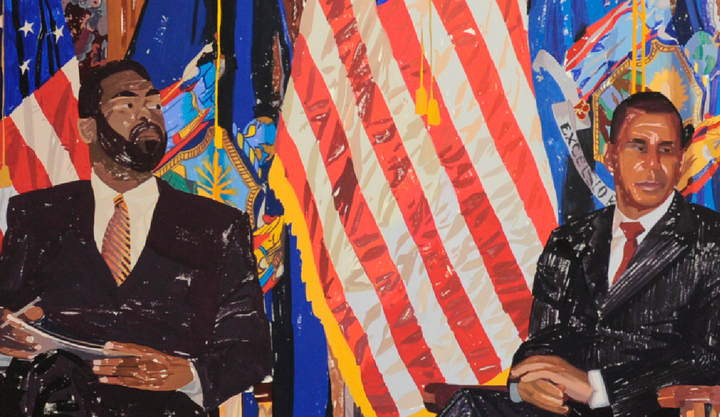
Peter Krashes, Governor and Flags, gouache on paper, 56.5 x 63 inches
For instance, readers of this review are viewing photographs of Krashes’ paintings made after photographs. But unlike viewing the paintings directly in the gallery -- where Krashes’ renderings transcend their photographic sources -- the limitations of viewing them on a screen or printed page as seen here, reduce our experience of them by diminishing their painterly details in reproduction. The result is the screen and print revert the paintings almost back to their photographic ‘impression'. It's a term not lightly chosen, as Krashes' paintings are a kind of contemporary impressionism, which is their strength. Even when his paintings are not derived entirely or in part from photographs, but merely mimic photographic effects, when reproduced they still are reduced to being read as photographic, a reading that diminishes their painterly achievements as virtuoso mimicry. If there is merit to this process, it’s that Krashes’ paintings partake in a negative strategy that conceptual artists of the 1960s and 1970s favored: the purposeful disparagement of photography as a secondhand means of experiencing art to underline that art can only truly be experienced in physical proximity with the actual work.
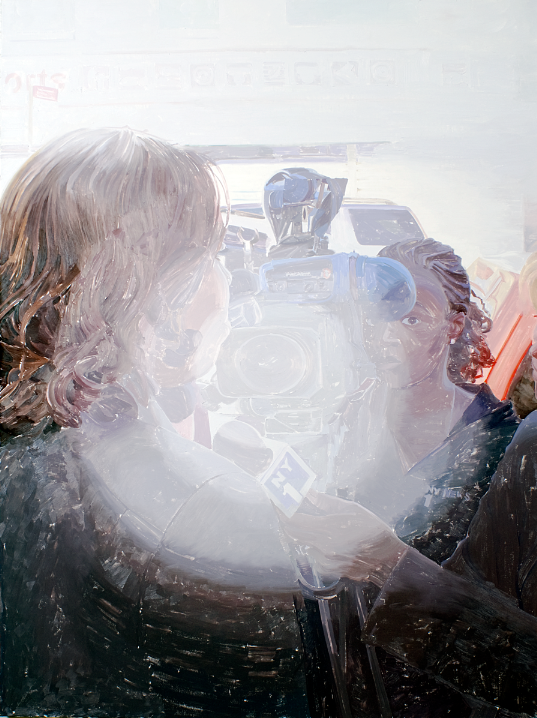
Peter Krashes, Cameras Always Find the Elected Official, gouache on paper, 2010 56.5 x 63 inches
In the gallery we can see Krashes' mediation of photographic images through the nervous system of the painter as imparted by his dazzling brushwork, just as we can appreciate his considerable skill as a figurative painter. I personally find his paintings to count among the most successful figurative renderings of his generation as much for their stylistic acumen as for their success as pictures of contemporary political and jurisprudent culture, event dissent. What they do not do, however -- and I state this because the artist has conveyed this as his intent -- is adequately essay what political and legal measures are in the best interests of the people.
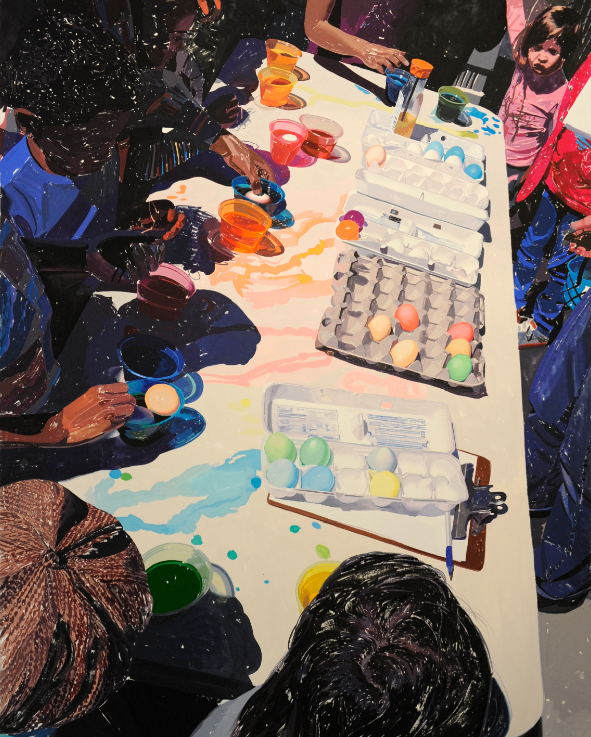
Peter Krashes, Egg Painting, 2015, gouache on paper, 65 x 48 inches
And really, can a non literary art ever hope to achieve this? This is a different question from that asking can a picture convey what is essential to being human. Photojournalism has been unparalleled in conveying through pictures what it means to be human by making people laugh or cry instantaneously. We also can be made to feel indignant by an injustice graphically conveyed, say by images of police unleashing dogs on pedestrians or aiming guns at unarmed demonstrators. But unless words or notable visual signifiers are represented in an image, we can’t read with any degree of certitude whether a depicted protest is pro or anti. We can only guess at them by, say, reading the picture’s semiotics — the protestors' hair length, skin color, clothing, signs carried that name the issue and desired effect of the protest. Hence, it doesn't suffice that Krashes' reputation for espousing liberal and progressive causes might carry his painting into a political discourse. We require a more articulated picture of the issues and players that he wishes to represent.
Listen to G. Roger Denson interviewed by Brainard Carey on Yale University Radio.
